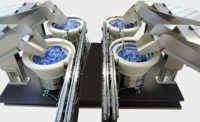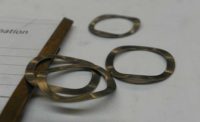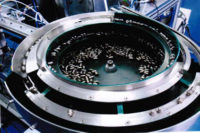Bowl feeds tough, tiny electrodes






The spark plug is an essential component of an internal combustion engine. A well-designed plug can maximize fuel economy, reduce emissions, increase engine performance and minimize maintenance.
Most spark plugs have a copper-core center electrode. Copper is an excellent conductor of heat and electricity. However, copper is soft and has a low melting point, so it is always covered with a nickel alloy to protect it. Some plugs also have a platinum or iridium tip on the electrodes. These metals reduce the wear caused by high-voltage sparks. They also help extend the interval between spark plug changes and decrease misfires.
Iridium is six times harder and eight times stronger than platinum. Its melting point is 700 degrees higher than platinum. Thanks to its strength, iridium spark plugs can last up to 25 percent longer than comparable platinum spark plugs.
However, that toughness can make iridium electrodes challenging to feed in an automated assembly system. Fortville Feeders Inc. learned that firsthand during a recent project. Fortville will service any feeder system, regardless of its manufacturer. A manufacturer of spark plugs called Fortville because it was having trouble getting small iridium electrode tips to feed correctly. The hardness of the tiny parts had a tendency to wear grooves into the bowl tooling and tracks of the feeder systems, causing misaligned parts and jammed lines.
After repairing the bowl to fill in the worn sections, Fortville engineers suggested a new feeding concept to the customer. Fortville designed a vibratory feeder with a linear track made of hardened steel. Part alignment would be done in the track, instead of the bowl, and the hardened steel would resist wear. With such a tiny part moving down the inline system, the track would not warp and the parts would not be misaligned.
The real challenge was orienting such a tiny part with little difference between its length and diameter. Only 25.4 microns separated the two measurements. The precision of the tooling in the system had to be exact; there was no room for error. Otherwise, the parts would misfeed or jam during tracking. The system used a high-level sensor to turn the bowl on and off as the parts moved down the track.
The new system fed the small parts much better than the old one. “Every aspect of the new parts feeder was meticulously designed and built by Fortville’s expert craftsmen,” says Larry Freiherr, managing partner at Fortville. “This is the type of challenge that many feeder bowl manufacturers would decline to quote. Fortville’s expertise in engineering and craftsmanship allows us to partner with clients to solve difficult parts feeding assignments, such as this project.”
For more information on parts feeders, call Fortville Feeders at 317-485-5195 or visit www.fortvillefeeders.com.
Looking for a reprint of this article?
From high-res PDFs to custom plaques, order your copy today!









